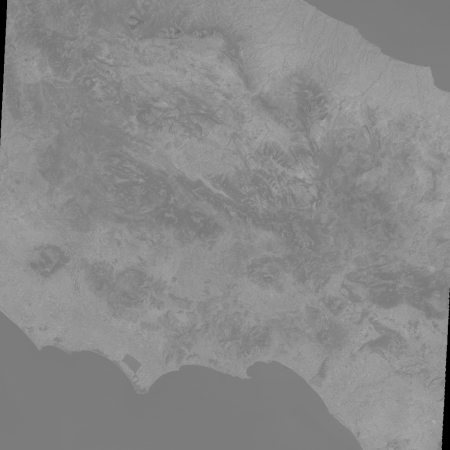2. Thermal Radiation
Absorption and emission: Kirchhoff's radiation law (3/4)
Brightness in the infrared
In the picture of the hot kiln, the darker colour of the cups in the foreground was based on their lower temperature. Brightness apparently decreases with dropping temperatures. At the same time, there is a change in colours: Red heat indicates lower temperatures than white heat. As the temperature continues to decrease down to room temperature, bodies do still emit radiation which is then in the infrared (about 10 μm). This part of the spectrum is called thermal infrared.
The clear atmosphere is partially transparent in the thermal infrared. It is thus possible to observe the earth's surface emission from a plane or satellite by help of an infrared camera. Brighter regions should be of a higher temperature than darker ones.
Right: RGB true colour image of the TM of central Italy as a cmposite of the red, the green and the blus TM channels. Again see the section about spectral analysis.
Source: ESA EduSpace Image Catalogue.
The different values for the shades of grey in the infrared satellite image in the left column result from different temperatures of the earth's surface. The degree of emission of different materials has to be considered though in order to deduce temperatures from different grey levels.
In the following, we will indicate temperatures in Kelvin only, so to say we will use the absolute or Kelvin temperature scale. The symbol for the temperature in Kelvin is . Its unit 1 K (1 Kelvin) is of the exact same amount than 1°C. At standard atmospheric pressure (1013 hPa), water has its freezing point at 273.2 K resp. 0°C, the boiling temperature of water is at 373.2 K resp. 100°C. The Kelvin scale thus is shifted towards values which are 273.2 degrees higher than the Celsius scale.
Typical degrees of emission of materials at room temperature in the spectral range of 8 to 14 μm. Source: Lillesand et al., 2008.
| Material | Degree of emission ε |
|---|---|
| Healthy green vegetation | 0.96 - 0.99 |
| Dry vegetation | 0.88 - 0.94 |
| Asphalt | 0.94 - 0.97 |
| Basalt | 0.92 - 0.96 |
| Granite | 0.83 - 0.87 |
| Dry mineral-rich soil | 0.92 - 0.96 |
| Wood | 0.87 |
| Water, seawater | 0.98 - 0.99 |
| Ice | 0.97 - 0.98 |
| Polished metal surfaces | 0.05 - 0.21 |
If the degree of emission is below 1, the temperature deduced from the brightness will be lower than the true temperature of an object measured by a thermometer. It is therefore called radiation temperature . The relation of the two temperatures is:
The relation can be proven only in following sections.
For healthy vegetation (≈0.98) at room temperature ≈293 K (20°C) the radiation temperature leaks only by 1.5 degrees. From polished metal (≈0.05) at the same true temperature, one finds ≈139 K, what equals -134°C.

